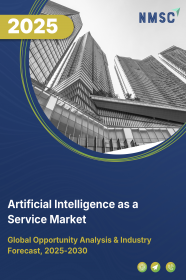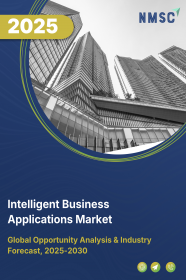
Artificial Intelligence as a Service Market by Component (Software and Service), by Deployment (Public, Private and Hybrid), by Offering (SaaS, PaaS and IaaS), by Technology (ML and Deep Learning, NLP and others), by Business Function (Finance, Marketing, Human Resource and others), by Organization Size (Large Enterprises, SMEs), and by Industry Vertical (Healthcare, Retail, Defense, Energy, Telecommunications and others)– Global Opportunity Analysis and Industry Forecast, 2025-2030
US Tariff Impact on Artificial Intelligence as a Service Market
Trump Tariffs Are Reshaping Global Business
Artificial Intelligence as a Service Industry Overview
The global Artificial Intelligence as a Service (AIaaS) Market size was valued at USD 24.73 billion in 2024 and is expected to be valued at USD 35.32 billion by the end of 2025. The industry is predicted to reach USD 190.63 billion by 2030 with a CAGR of 40.2% from 2026 to 2030. The market is experiencing significant evolution, driven by factors such as the rising adoption of artificial intelligence across industries, the growing demand for cost-efficient and scalable AI solutions, and the increasing advancements in cloud computing infrastructure that support seamless AI deployment. These trends are propelled by drivers such as the widespread integration of AI to improve operational performance, the flexibility and affordability of AIaaS for businesses of all sizes, contributing to the market's overall growth potential and expanding industry size.
However, the market faces restraints including persistent privacy and security concerns, particularly related to data protection, compliance, and trust in third-party AI platforms. These challenges may slow adoption in sensitive or highly regulated sectors. However, various opportunities for industry players lie in the ongoing democratization of AI, particularly through the creation of user-friendly, low-code or no-code platforms that make AI tools more accessible to non-technical users. This shift has the potential to significantly broaden market reach, foster innovation, and expand the overall market size.
The Rising Adoption of AI Fuels the Growth of the Artificial Intelligence as a Service Market
The increasing adoption of AI technologies is a significant driver for the artificial intelligence as a service market demand. Businesses across diverse sectors are recognizing the transformative potential of AI to automate tasks, optimize processes, and enhance decision-making. Globally, a substantial number of companies are already using AI, and an even larger number of companies are exploring its implementation within their organizations.
The projected market growth to USD 168.2 billion by 2032 underscores this strong adoption trend. The financial services industry leverages AI for enhanced efficiency, client engagement, and fraud detection. This broad applicability and the tangible benefits derived from AI are significantly contributing to the growth potential and expanding industry size of the market.
Cost Efficiency and Scalability of AI Propel the AIaaS Market Expansion
The growing demand for cost-effective and scalable AI solutions is another crucial driver behind the growing AIaaS market. Developing in-house AI capabilities involves complex processes and substantial capital investment, creating a barrier for many organizations, particularly smaller businesses. This model allows businesses to leverage machine learning algorithms, natural language processing, and predictive analytics without the need for extensive infrastructure or a dedicated team of AI specialists. The cost efficiency and scalability are particularly attractive to businesses looking to optimize their processes and drive growth without incurring significant upfront costs.
Advancements in Cloud Computing Further Boost the Market Growth
Significant advancements in cloud computing technologies form the essential infrastructure for the delivery and expansion of the AI as a service (AIaaS) market. Cloud platforms like Google Cloud AI, AWS AI services, and Microsoft's Azure Cognitive Services are integrating AI services into their offerings, making them readily available to a wide range of users.
Application Programming Interfaces (APIs) play a vital role in this ecosystem, acting as software bridges that enable easy communication and integration between different applications and AI models offered by AIaaS providers. The continuous innovation in cloud computing, coupled with the increasing sophistication of AI models, is further propelling the growth and expanding the industry size of the industry.
Privacy and Security Concerns Hinder the Growth of the Market
Concerns surrounding data privacy and security present a notable restraint for the AI-powered analytics services. As businesses outsource their AI needs and share sensitive data with third-party AIaaS providers, concerns regarding data protection, compliance with regulations (like EU GDPR), and the potential for data breaches arise. These concerns create hesitation among potential adopters, particularly in industries with stringent data privacy requirements. Building trust through transparent data handling practices, adherence to global compliance measures, and the implementation of strong security protocols by AIaaS vendors are essential to mitigate this restraint and foster greater confidence in the market.
Democratization of AI Creates Future Growth Opportunities for the Market
The democratization of AI presents a transformative opportunity for the artificial intelligence as a service (AIaaS) market trends. The shift toward user-friendly AI tools and platforms that require minimal coding skills is driving this trend, enabling small and medium-sized enterprises (SMEs) previously excluded due to high costs or technical complexity to harness AI’s potential. SMEs can now leverage AI to streamline operations, enhance customer engagement, and foster innovation.
For example, CHATCRYPTO, a blockchain enterprise, announced the launch of its innovative AIaaS platform, powered by the ChatCrypto token, in April 2023. This platform is designed to democratize AI by making advanced AI technologies accessible to SMEs through intuitive interfaces, pre-trained models, and comprehensive support resources. Furthermore, AIaaS providers are capitalizing on this opportunity by developing intuitive interfaces, offering pre-trained models for common use cases, and providing robust support systems. These advancements attract a broader customer base, significantly expanding the market size and growth potential of the AIaaS industry in the upcoming years.
Market Segmentations and Scope of the Study
The artificial intelligence as a service market report is segmented on the basis of component, deployment, offering, technology, business function, organization size, industry vertical, and region. On the basis of component, the market is divided into software and services. The software is further segmented into data storage and archiving, modeling and processing, cloud and web-based application programming interface (APIs), and others. The service is further segmented into machine learning as a service (MLAAS), natural language processing as a service (NLPAAS), computer vision as a service, predictive analytics and data science as a service (DSAAS), and generative AI as a service. On the basis of deployment, the market is classified into public, private, and hybrid. On the basis of offering, the market is segmented into software as a service (SaaS), platform as a service (PaaS), and infrastructure as a service (IaaS). On the basis of technology, the market is segmented into machine learning (ML) and deep learning, natural language processing (NLP), context awareness, computer vision, and others. On the basis of business function, the market is segmented into finance, marketing, sales, operations & supply chain, and human resources. On the basis of organizational size, the market is segmented into large enterprises and small and medium-sized enterprises (SMEs). On the basis of industry vertical, the market is segmented into banking, financial, and insurance (BFSI), healthcare, retail, telecommunications, defense, energy, and others. Regional breakdown and analysis of each of the aforesaid segments include regions comprising North America, Europe, Asia-Pacific, and RoW.
Geographical Analysis
North America currently holds a dominant position in the global AI as a service market share. This can be attributed to the presence of prominent and large design organizations in the region, coupled with substantial investments in marketing strategies. Major players like Google Cloud AI, AWS AI services, and Microsoft's Azure Cognitive Services, all based in North America, have been instrumental in driving the adoption of AIaaS offerings. The high level of technological advancement and early adoption of AI technologies across various sectors within North America contribute significantly to its growing market size.
Europe is emerging as a region with the fastest growth rate in the market and is anticipated to attain rapid growth, suggesting a substantial increase in its industry size over the forecast period. This growth is likely fuelled by increasing awareness of AIaaS benefits and a growing number of businesses exploring cloud-based AI solutions. Furthermore, European initiatives and investments in digital transformation and AI technologies are expected to contribute significantly to this upward market trend.
The Asia-Pacific region holds a significant revenue share in the global AI as a service market. This robust market share is driven by the high acceptance of smartphones, the continuous use of social media, and the emergence of novel AI websites in the region. Supportive government policies aimed at boosting digitization in countries like China and India are also playing a crucial role in propelling market development and enhancing the growth potential of AIaaS in this region. The diverse health systems and robust economic growth across the Asia-Pacific area, encompassing over 40 countries and a significant portion of the world's population, also present unique opportunities and challenges for the healthcare business and the adoption of AI technologies within it.
The Rest of the World also presents growth potential in the market. These regions are at varying stages of AI adoption, with factors such as infrastructure development, technological readiness, and awareness levels influencing their respective market trends. As cloud computing infrastructure expands globally and the benefits of AIaaS become more widely understood, it can be anticipated to experience steady growth in these regions, contributing to the overall expansion of the industry.
Strategic Analysis of the Companies Operating in the Market
The key players in the global AIaaS industry, including Microsoft Corporation, Amazon Web Services, Inc., and NVIDIA Corporation, are making notable strides to strengthen their positions. For instance, Microsoft Corporation launched System Center 2025 in November 2024, enhancing data center management, and committed USD 80 billion in FY2025 for AI-enabled data centers globally. Amazon Web Services, Inc. introduced Amazon Q, a generative AI assistant, in 2023 and reduced S3 Express One Zone pricing in 2025 to boost competitiveness. NVIDIA Corporation announced the RTX 50 series GPUs at CES 2025, targeting AI and gaming applications, and partnered with Google to run Gemini on Blackwell systems.
Besides this, these companies face significant challenges, including high infrastructure costs due to AI and cloud scaling, particularly impacting smaller firms. Regulatory pressures in Europe and North America demand stricter data privacy and sustainability practices, squeezing margins for players, while skill shortages in developing regions hinder innovation. However, government incentives, such as AI development grants announced in 2024, could ease financial burdens. With growing demand for AI and cloud solutions, the market is projected to create millions of jobs by 2030, and innovations in digital platforms are enhancing supply chains for market expansion.
Key Benefits
-
The report provides quantitative analysis and estimations of the industry from 2025 to 2030, which assists in identifying the prevailing artificial intelligence as a service market opportunities.
-
The study comprises a deep dive analysis of the current and future AIaaS market trends to depict prevalent investment pockets in the sector.
-
Information related to key drivers, restraints, and opportunities and their impact on the market is provided in the report.
-
Competitive analysis of the players, along with their market share, is provided in the report.
-
SWOT analysis and Porter's Five Forces model are elaborated in the study.
-
Value chain analysis in the market study provides a clear picture of the roles of stakeholders.
Artificial Intelligence as a Service Market Key Segments
By Component
-
Software
-
Data Storage and Archiving
-
Modeler and Processing
-
Cloud and Web-Based Application Programming Interface (APIs)
-
Others
-
-
Services
-
Machine Learning as a Service (MLAAS)
-
Natural Language Processing as a Service (NLPAAS)
-
Computer Vision as a Service
-
Predictive Analytics and Data Science as a Service (DSAAS)
-
Generative AI as a Service
-
By Deployment
-
Public
-
Private
-
Hybrid
By Offering
-
Software as a Service (SaaS)
-
Platform as a Service (PaaS)
-
Infrastructure as a Service (IaaS)
By Technology
-
Machine Learning (ML) and Deep Learning
-
Machine Learning (ML) and Deep Learning
-
Context Awareness
-
Computer Vision
-
Others
By Business Function
-
Finance
-
Marketing
-
Sales
-
Operations & Supply Chain
-
Human Resource
By Organization Size
-
Large Enterprises
-
Small and Medium-sized Enterprises (SMEs)
By Industry Vertical
-
Banking, Financial, and Insurance (BFSI)
-
Healthcare
-
Retail
-
Telecommunications
-
Defense
-
Energy
-
Others
By Region
-
North America
-
The U.S.
-
Canada
-
Mexico
-
-
Europe
-
The UK
-
Germany
-
France
-
Italy
-
Spain
-
Denmark
-
Netherlands
-
Finland
-
Sweden
-
Norway
-
Russia
-
Rest of Europe
-
-
Asia Pacific
-
China
-
Japan
-
India
-
South Korea
-
Australia
-
Indonesia
-
Singapore
-
Taiwan
-
Thailand
-
Rest of Asia Pacific
-
-
RoW
-
Latin America
-
Middle East
-
Africa
-
Key Players
-
Microsoft Corporation
-
IBM Corporation
-
Amazon Web Services, Inc.
-
BigML, Inc.
-
Ernst & Young Global Limited (EY)
-
Salesforce, Inc.
-
Intel Corporation
-
Wipro Limited
-
Mighty AI, Inc.
-
Bain & Company, Inc.
-
Keystride
-
NVIDIA Corporation
-
Ailoitte Technologies Pvt Ltd.
-
Siemens AG
-
Google LLC
REPORT SCOPE AND SEGMENTATION:
|
Parameters |
Details |
|
Market Size in 2024 |
USD 24.73 Billion |
|
Revenue Forecast in 2030 |
USD 190.63 Billion |
|
Growth Rate |
CAGR of 40.2% from 2026 to 2030 |
|
Analysis Period |
2024–2030 |
|
Base Year Considered |
2024 |
|
Forecast Period |
2025–2030 |
|
Market Size Estimation |
Billion (USD) |
|
Growth Factors |
|
|
Countries Covered |
28 |
|
Companies Profiled |
15 |
|
Market Share |
Available for 10 companies |
|
Customization Scope |
Free customization (equivalent to up to 80 working hours of analysts) after purchase. Addition or alteration to the country, regional, and segment scope. |
|
Pricing and Purchase Options |
Avail customized purchase options to meet your exact research needs. |

















 Speak to Our Analyst
Speak to Our Analyst





















